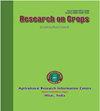提高作物秸秆生物炭对越南中部水稻(Oryza sativa L.)干物质、产量积累和土壤有机碳的功效
Q3 Agricultural and Biological Sciences
引用次数: 0
摘要
由于肥料施用和土壤固碳不平衡,从作物秸秆中提取的生物炭在改良退化的水稻土壤中发挥着重要作用。本研究旨在评估生物炭的最佳施用类型和施用量,以提高水稻干物质和土壤有机碳含量。因此,研究人员于 2023 年春夏两季在顺化大学农林学院进行了盆栽实验。试验共采用了 12 个处理,包括 2 种生物炭(稻壳和花生壳)和 6 种施用率(0、1、2、3、4、5%),采用随机区组设计,三次重复。研究结果表明,两种生物炭的施用量均为 5%时,芽干物质比对照组高 9.5 - 27.0%(春季)和 19.1 - 26.9%(夏季)。在两个季节,施用稻壳生物炭比施用花生壳生物炭在相同施用量下(0.30 - 0.46 克/株)的嫩枝干物质更高。同样,当作物秸秆生物炭的施用量为 5%时,有机碳的含量最高(2.15%-2.21%)。农作物秸秆生物炭被认为是增加作物干物质和土壤有机碳的良好添加剂。本文章由计算机程序翻译,如有差异,请以英文原文为准。
Enhancing the efficacy of biochar derived from crop residues on rice (Oryza sativa L.) dry matter, yield accumulation and soil organic carbon in Central Vietnam
Biochar from crop residues plays an important role in reclamation of degraded rice soil due to imbalance fertilizer application and soil carbon sequestration. The objective of this study aimed to evaluate the best type and rate of biochar application for rice dry matter and soil organic carbon improvement. Therefore, pot experiments were carried out in two seasons of spring and summer 2023 at the University of Agriculture and Forestry, Hue University. Twelve treatments including 2 types of biochar (rice husk and peanut shell) and 6 application rates (0, 1, 2, 3, 4, 5%) were used and arranged in a randomized block design with three replications. Research results showed that the shoot dry matter was higher 9.5 – 27.0% (spring season) and 19.1 – 26.9% (summer season) at a rate of 5% application in both types of biochar than control. Rice husk biochar application had higher shoot dry matter than peanut shell biochar application in the same application rate from 0.30 – 0.46 g/plant in both seasons. Similarly, organic carbon was found the highest content (2.15 - 2.21%) when the application of biochar from crop residues at a rate of 5%. Biochar from crop residues is considered as a good amendment for increasing crop dry matter and soil organic carbon.
求助全文
通过发布文献求助,成功后即可免费获取论文全文。
去求助
来源期刊

Research on Crops
Agricultural and Biological Sciences-Soil Science
CiteScore
1.50
自引率
0.00%
发文量
93
审稿时长
1 months
期刊介绍:
The Research on Crops is a peer-reviewed journal publishing original research papers, review articles and short communications in English on all basic and applied aspects of crop sciences, agricultural water management, agro-climatology, agroforestry, agronomy, crop production, crop protection, cropping systems, food science & technology, genetics & plant breeding, horticulture, plant & soil science, plant biotechnology, plant nutrition, post-harvest management of crops, seed science, soil management & tillage, vegetables, weed science, agricultural engineering, agri-business, agricultural economics and extension, etc. The aim of the journal is to provide a forum for the scientific community to publish their latest research findings.
The manuscripts submitted for publication should not contain data older than 4 years on the date of submission.
The articles submitted for publication in this journal should not be submitted elsewhere simultaneously for publication in another journal. These should not carry any copyright material without prior permission of copyright holder.
The articles should present a complete picture of the investigation made and should not be split into parts.
There is no prescribed limit regarding the number of pages in case of full-length articles. However, the authors are advised to keep the length of their articles from 4 to 10 full printed pages of the journal.
The articles should be divided into the sub-sections: ABSTRACT, INTRODUCTION, MATERIALS AND METHODS, RESULTS AND DISCUSSION, CONCLUSIONS, and REFERENCES. Tables and figures should be appended separately at the end.
 求助内容:
求助内容: 应助结果提醒方式:
应助结果提醒方式:


